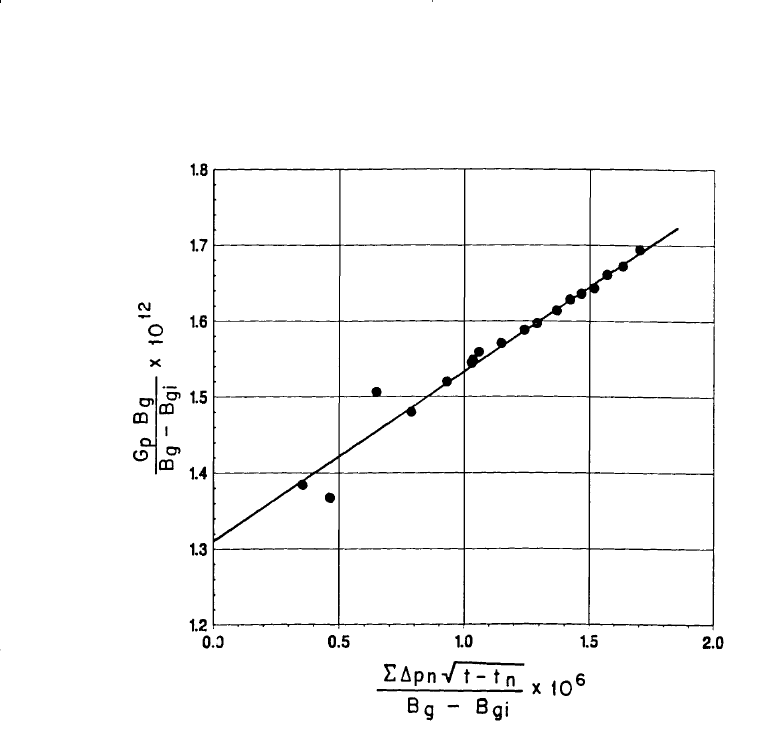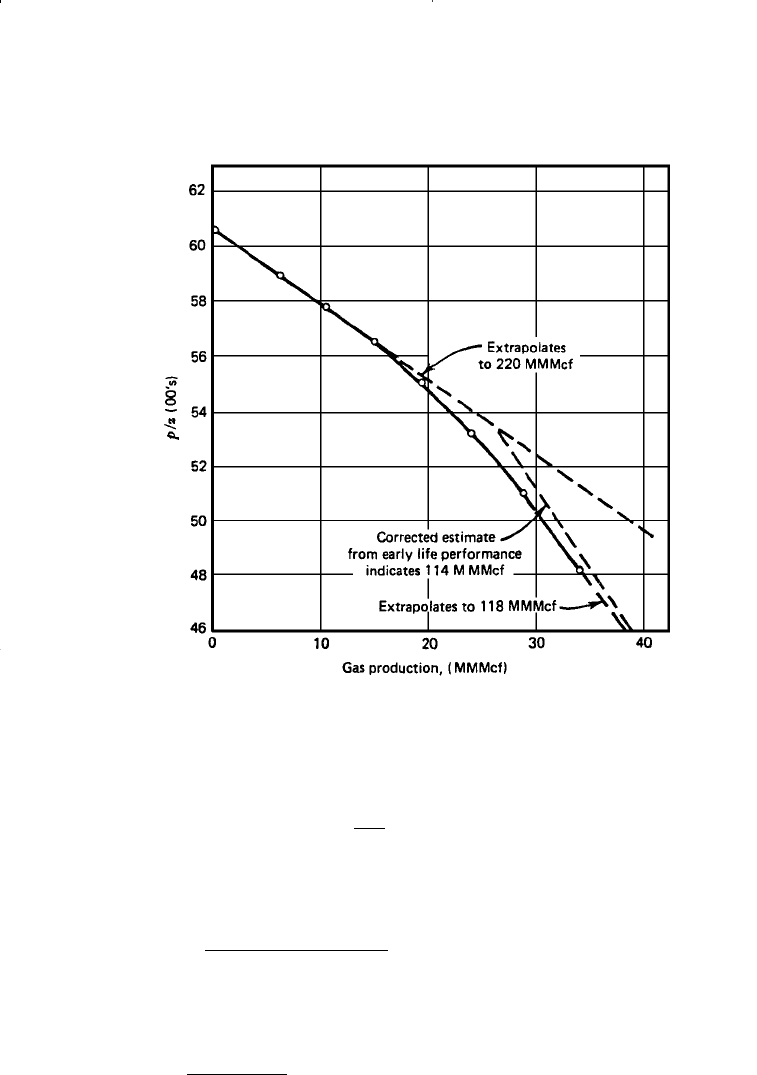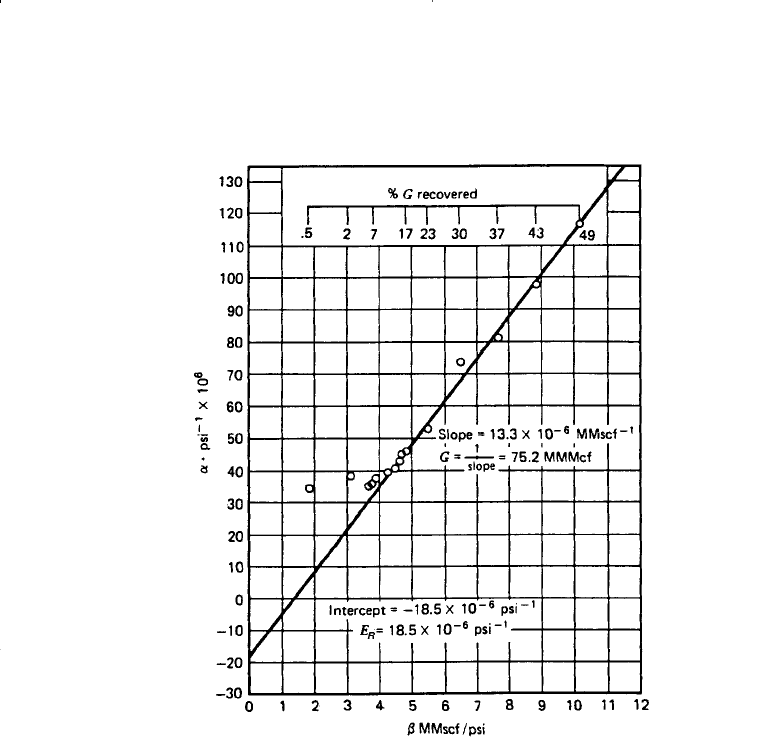Tarek Ahmed. Reservoir engineering handbook
Подождите немного. Документ загружается.


All gas reservoir performance is related to effective compressibility,
not gas compressibility. When the pressure is abnormal and high, effec-
tive compressibility may equal two or more times that of gas compress-
ibility. If effective compressibility is equal to twice the gas compressibili-
ty, then the first cubic foot of gas produced is due to 50% gas expansion
and 50% formation compressibility and water expansion. As the pressure
is lowered in the reservoir, the contribution due to gas expansion
becomes greater because gas compressibility is approaching effective
compressibility. Using formation compressibility, gas production, and
shut-in bottom-hole pressures, two methods are presented for correcting
the reserve estimates from the early life data (assuming no water influx).
Roach (1981) proposed a graphical technique for analyzing abnormal-
ly pressured gas reservoirs. The MBE as expressed by Equation 13-17
may be written in the following form for a volumetric gas reservoir:
848 Reservoir Engineering Handbook
Figure 13-11. Havlena-Odeh MBE plot for Example 13-4.
Reservoir Eng Hndbk Ch 13 2001-10-24 15:13 Page 848

where
Defining the rock expansion term E
R
as:
Equation 13-26 can be expressed as:
c
t
= 1 - E
R
(p
i
- p) (13 - 28)
E
ccS
S
R
fwwi
wi
=
+
-1
(13- 27)
c
ccS pp
S
t
f w wi i
wi
=-
+-
-
1
1
()()
(13- 26)
(/) ( / )pzc pz
G
G
tii
p
=--
È
Î
Í
˘
˚
˙
1 (13 - 25)
Gas Reservoirs 849
Figure 13-12. P/z versus cumulative production. North Ossum Field, Lafayette
Parish, Louisiana NS2B Reservoir. (After Hammerlindl.)
Reservoir Eng Hndbk Ch 13 2001-10-24 15:13 Page 849

Equation 13-25 indicates that plotting (p/z)c
t
versus cumulative gas
production on Cartesian coordinates results in a straight line with an x-
intercept at the original gas in place and a y-intercept at the original p/z.
Since c
t
is unknown and must be found by choosing the compressibility
values resulting in the best straight-line fit, this method is a trial-and-
error procedure.
Roach used the data published by Duggan (1972) for the Mobil-David
Anderson gas field to illustrate the application of Equations 13-25 and
13-28 to determine graphically the gas initially in place. Duggan reported
that the reservoir had an initial pressure of 9507 psig at 11,300 ft. Volu-
metric estimates of original gas in place indicated that the reservoir con-
tains 69.5 MMMscf. The historical p/z versus G
p
plot produced an initial
gas in place of 87 MMMscf, as shown in Figure 13-13.
Using the trial-and-error approach, Roach showed that a value of the
rock expansion term E
R
of 18.5 ¥ 10
-6
would result in a straight line with
a gas initially in place of 75 MMMscf, as shown in Figure 13-13.
850 Reservoir Engineering Handbook
Figure 13-13. Mobil-David Anderson “L” p/z versus cumulative production. (After
Roach.)
Reservoir Eng Hndbk Ch 13 2001-10-24 15:13 Page 850

To avoid the trial-and-error procedure, Roach proposed that Equations
13-25 and 13-28 can be combined and expressed in a linear form by:
with
where G = initial gas in place, scf
E
R
= rock expansion term, psi
-1
S
wi
= initial water saturation
Roach (1981) shows that a plot of a versus b will yield a straight line
with slope 1/G and y-intercept =-E
R
. To illustrate his proposed method-
ology, he applied Equation 13-29 to the Mobil-David gas field as shown
in Figure 13-14. The slope of the straight line gives G = 75.2 MMMscf
and the intercept gives E
R
= 18.5 ¥ 10
-6
.
Begland and Whitehead (1989) proposed a method to predict the per-
cent recovery of volumetric, high-pressured gas reservoirs from the ini-
tial pressure to the abandonment pressure with only initial reservoir data.
The proposed technique allows the pore volume and water compressibili-
ties to be pressure-dependent. The authors derived the following form of
the MBE for a volumetric gas reservoir:
where r = recovery factor
B
g
= gas formation volume factor, bbl/scf
c
f
= formation compressibility, psi
-1
B
tw
= two-phase water formation volume factor, bbl/STB
B
twi
= initial two-phase water formation volume factor, bbl/STB
r
G
G
BB
B
BS
S
B
B
cp p
S
B
pggi
g
gi wi
wi
tw
twi
fi
wi
g
==
-
+
-
-+
-
È
Î
Í
˘
˚
˙
1
1
()
(13- 32)
b=
-
(/)(/)
()
pz pz
pp
ii
i
(13- 31)
a=
-
-
[( / )/( / )]
()
pz pz
pp
ii
i
1
(13- 30)
ab=
Ê
Ë
ˆ
¯
-
1
G
E
R
(13- 29)
Gas Reservoirs 851
Reservoir Eng Hndbk Ch 13 2001-10-24 15:13 Page 851

The water two-phase FVF is determined from:
B
tw
= B
w
+ B
g
(R
swi
- R
sw
) (13-33)
where R
sw
= gas solubility in the water phase, scf/STB
B
w
= water FVF, bbl/STB
The following three assumptions are inherent in Equation 13-32:
• A volumetric, single-phase gas reservoir
• No water production
• The formation compressibility c
f
remains constant over the pressure
drop (p
i
- p).
852 Reservoir Engineering Handbook
Figure 13-14. Mobil-David Anderson “L” gas material-balance. (After Roach.)
Reservoir Eng Hndbk Ch 13 2001-10-24 15:13 Page 852

The authors point out that the changes in water compressibility c
w
are
implicit in the change of B
tw
with pressure as determined by Equation
13-33.
Begland and Whitehead suggest that because c
f
is pressure dependent,
Equation 13-32 is not correct as reservoir pressure declines from the ini-
tial pressure to some value several hundred psi lower. The pressure
dependence of c
f
can be accounted for in Equation 13-32 is solved in an
incremental manner.
Effect of Gas Production Rate on Ultimate Recovery
Volumetric gas reservoirs are essentially depleted by expansion and,
therefore, the ultimate gas recovery is independent of the field produc-
tion rate. The gas saturation in this type of reservoir is never reduced;
only the number of pounds of gas occupying the pore spaces is reduced.
Therefore, it is important to reduce the abandonment pressure to the low-
est possible level. In closed-gas reservoirs, it is not uncommon to recover
as much as 90 percent of the initial gas in place.
Cole (1969) points out that for water-drive gas reservoirs, recovery
may be rate dependent. There are two possible influences which produc-
ing rate may have on ultimate recovery. First, in an active water-drive
reservoir, the abandonment pressure may be quite high, sometimes only a
few psi below initial pressure. In such a case, the number of pounds of
gas remaining in the pore spaces at abandonment will be relatively great.
The encroaching water, however, reduces the initial gas saturation.
Therefore, the high abandonment pressure is somewhat offset by the
reduction in initial gas saturation. If the reservoir can be produced at a
rate greater than the rate of water influx rate, without water coning, then
a high producing rate could result in maximum recovery by taking
advantage of a combination of reduced abandonment pressure and reduc-
tion in initial gas saturation. Second, the water coning problems may be
very severe in gas reservoirs, in which case it will be necessary to restrict
withdrawal rates to reduce the magnitude of this problem.
Cole suggests that the recovery from water-drive gas reservoirs is sub-
stantially less than recovery from closed-gas reservoirs. As a rule of
thumb, recovery from a water-drive reservoir will be approximately 50 to
80 percent of the initial gas in place. The structural location of producing
wells and the degree of water coning are important considerations in
determining ultimate recovery.
Gas Reservoirs 853
Reservoir Eng Hndbk Ch 13 2001-10-24 15:13 Page 853

A set of circumstances could exist—such as the location of wells very
high on the structure with very little coning tendencies—where water-
drive recovery would be greater than depletion-drive recovery. Abandon-
ment pressure is a major factor in determining recovery efficiency, and
permeability is usually the most important factor in determining the mag-
nitude of the abandonment pressure. Reservoirs with low permeability
will have higher abandonment pressures than reservoirs with high perme-
ability. A certain minimum flow rate must be sustained, and a higher per-
meability will permit this minimum flow rate at a lower pressure.
PROBLEMS
1. The following information is available on a volumetric gas reservoir:
Initial reservoir temperature, T
i
= 155°F
Initial reservoir pressure, p
i
= 3500 psia
Specific gravity of gas, g
g
= 0.65 (air = 1)
Thickness of reservoir, h = 20 ft
Porosity of the reservoir, f=10%
Initial water saturation, S
wi
= 25%
After producing 300 MMscf, the reservoir pressure declined to 2500 psia.
Estimate the areal extent of this reservoir.
2. The following pressures and cumulative production data
2
are available
for a natural gas reservoir:
Reservoir Gas deviation Cumulative
pressure, factor, production,
psia z MMMscf
2080 0.759 0
1885 0.767 6.873
1620 0.787 14.002
1205 0.828 23.687
888 0.866 31.009
645 0.900 36.207
a. Estimate the initial gas in place.
b. Estimate the recoverable reserves at an abandonment pressure of
500 psia. Assume z
a
= 1.00.
854 Reservoir Engineering Handbook
2
Ikoku, C., Natural Gas Reservoir Engineering, John Wiley and Sons, 1984.
Reservoir Eng Hndbk Ch 13 2001-10-24 15:13 Page 854

c. What is the recovery factor at the abandonment pressure of 500
psia?
3. A gas field with an active water drive showed a pressure decline from
3000 to 2000 psia over a 10-month period. From the following produc-
tion data, match the past history and calculate the original hydrocarbon
gas in the reservoir. Assume z = 0.8 in the range of reservoir pressures
and T = 140°F.
Data
t, months 0 2.5 5.0 7.5 10.0
p, psia 3000 2750 2500 2250 2000
G
p
, MMscf 0 97.6 218.9 355.4 500.0
4. A volumetric gas reservoir produced 600 MMscf of 0.62 specific grav-
ity gas when the reservoir pressure declined from 3600 to 2600 psi.
The reservoir temperature is reported at 140°F. Calculate:
a. Gas initially in place
b. Remaining reserves to an abandonment pressure of 500 psi
c. Ultimate gas recovery at abandonment
5. The following information on a water-drive gas reservoir is given:
Bulk volume = 100,000 acre-ft
Gas Gravity = 0.6
Porosity = 15%
S
wi
= 25%
T = 140°F
p
i
= 3500 psi
Reservoir pressure has declined to 3000 psi while producing 30
MMMscf of gas and no water production. Calculate cumulative water
influx.
6. The pertinent data for the Mobil-David field is given below.
G = 70 MMMscf p
i
= 9507 psi f=24% S
wi
= 35%
c
w
= 401 ¥ 10
-6
psi
-1
c
f
= 3.4 ¥ 10
-6
psi
-1
g
g
= 0.94 T = 266°F
For this volumetric abnormally-pressured reservoir, calculate and
plot cumulative gas production as a function of pressure.
7. The Big Butte field is a volumetric dry-gas reservoir with a recorded
initial pressure of 3,500 psi at 140°F. The specific gravity of the pro-
Gas Reservoirs 855
Reservoir Eng Hndbk Ch 13 2001-10-24 15:13 Page 855

duced gas is measured at 0.65. The following reservoir data are avail-
able from logs and core analysis:
Reservoir area = 1500 acres
Thickness = 25 ft
Porosity = 15%
Initial water saturation = 20%
Calculate:
a. Initial gas in place as expressed in scf
b. Gas viscosity at 3,500 psi and 140°F
REFERENCES
1. Begland, T., and Whitehead, W., “Depletion Performance of Volumetric
High-Pressured Gas Reservoirs,” SPE Reservoir Engineering, August 1989,
pp. 279–282.
2. Cole, F. W., Reservoir Engineering Manual. Houston: Gulf Publishing Co.,
1969.
3. Dake, L., The Practice of Reservoir Engineering. Amsterdam: Elsevier Pub-
lishing Company, 1994.
4. Duggan, J. O., “The Anderson ‘L’—An Abnormally Pressured Gas Reservoir
in South Texas,” Journal of Petroleum Technology, February 1972, Vol. 24,
No. 2, pp. 132–138.
5. Hammerlindl, D. J., “Predicing Gas Reserves in Abnormally Pressure Reser-
voirs.” SPE Paper 3479 presented at the 46th Annual Fall Meeting of SPE,
New Orleans, October 1971.
6. Havlena, D., and Odeh, A. S., “The Material Balance as an Equation of a
Straight Line,” Trans. AIME, Part 1: 228 I-896 (1963); Part 2: 231 I-815
(1964).
7. Ikoku, C., Natural Gas Reservoir Engineering. John Wiley & Sons, Inc.,
1984.
8. Roach, R. H., “Analyzing Geopressured Reservoirs—A Material Balance
Technique,” SPE Paper 9968, Society of Petroleum Engineers of AIME, Dal-
las, December 1981.
9. Van Everdingen, A. F., and Hurst, W., “Application of Laplace Transform to
Flow Problems in Reservoirs,” Trans. AIME, 1949, Vol. 186, pp. 305–324B.
856 Reservoir Engineering Handbook
Reservoir Eng Hndbk Ch 13 2001-10-24 15:13 Page 856

The terms primary oil recovery, secondary oil recovery, and tertiary
(enhanced) oil recovery are traditionally used to describe hydrocarbons
recovered according to the method of production or the time at which
they are obtained.
Primary oil recovery describes the production of hydrocarbons under
the natural driving mechanisms present in the reservoir without supple-
mentary help from injected fluids such as gas or water. In most cases, the
natural driving mechanism is a relatively inefficient process and results
in a low overall oil recovery. The lack of sufficient natural drive in most
reservoirs has led to the practice of supplementing the natural reservoir
energy by introducing some form of artificial drive, the most basic
method being the injection of gas or water.
Secondary oil recovery refers to the additional recovery that results
from the conventional methods of water injection and immiscible gas
injection. Usually, the selected secondary recovery process follows the
primary recovery but it can also be conducted concurrently with
the primary recovery. Waterflooding is perhaps the most common method
of secondary recovery. However, before undertaking a secondary recovery
project, it should be clearly proven that the natural recovery processes are
insufficient; otherwise there is a risk that the substantial capital invest-
ment required for a secondary recovery project may be wasted.
Tertiary (enhanced) oil recovery is that additional recovery over and
above what could be recovered by primary and secondary recovery meth-
ods. Various methods of enhanced oil recovery (EOR) are essentially
857
CHAPTER 14
PRINCIPLES OF
WATERFLOODING
Reservoir Eng Hndbk Ch 14 2001-10-25 17:37 Page 857
